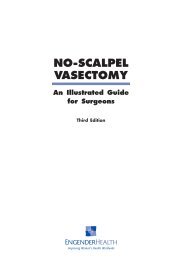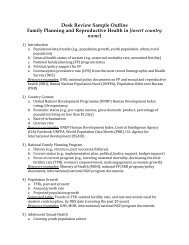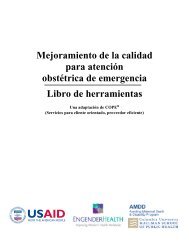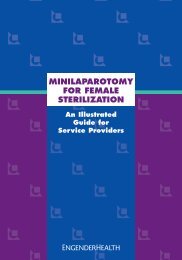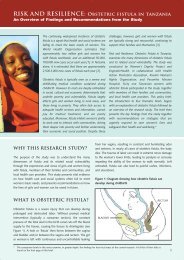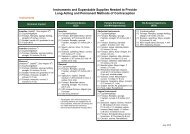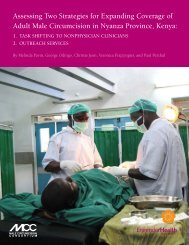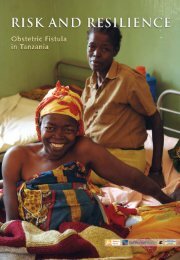COPE® FOR MALE CIRCUMCISION SERVICES - EngenderHealth
COPE® FOR MALE CIRCUMCISION SERVICES - EngenderHealth
COPE® FOR MALE CIRCUMCISION SERVICES - EngenderHealth
Create successful ePaper yourself
Turn your PDF publications into a flip-book with our unique Google optimized e-Paper software.
COPE for Male Circumcision Services<br />
been applied to many different health services, from family planning to maternal and child<br />
health services, to infection prevention practices, and to HIV prevention, care, and<br />
treatment services for all staff in a health care setting.<br />
■ COPE helps facility managers work more effectively. Although service managers may<br />
initially find introducing COPE and QI to be time-consuming, once staff become involved in<br />
solving day-to-day problems on their own, managers generally find that they have more<br />
time to focus on major problems.<br />
■ COPE helps reduce costs associated with poor quality. If something is not done<br />
correctly the first time, it must be fixed, often repeatedly. Moreover, the consequences may<br />
be serious, in terms of both cost and the health of individuals and the community. COPE<br />
helps reduce the cost of poor quality by assisting staff to identify and solve problems,<br />
focusing on processes and systems to prevent problems from occurring in the future.<br />
Implementing COPE<br />
A brief overview of the COPE process, including a description of each of these tools, is<br />
presented below. For a detailed explanation of the COPE process and of the use of each tool,<br />
please refer to the COPE Handbook, the reference and “how-to” manual that accompanies<br />
this toolbook.<br />
Getting Started<br />
Before conducting COPE, facilitators should read through the COPE Handbook in its entirety<br />
and become familiar with the process and the tools. The initial COPE exercise takes place<br />
over a period of two to three days. Follow-up exercises should be conducted every three to six<br />
months thereafter and take two or three days to complete, depending on whether the facility<br />
opts to perform a Client-Flow Analysis. (For an overview of the COPE process, see Figure 3, p.<br />
8.) When conducting COPE for MC services, it is important to remember that, like other<br />
areas related to HIV and AIDS (keep in mind that many men will seek circumcision for<br />
prevention of HIV infection), MC services need to address potential stigmatization that often<br />
occurs in HIV services.<br />
The Facilitator<br />
When health care management decides to introduce COPE at a facility or in some other<br />
service setting for the first time, they should seek help from an experienced COPE facilitator.<br />
This is usually an external facilitator (from the Ministry of Health, a nongovernmental<br />
organization, or a technical assistance agency) who has been trained in COPE and has<br />
experience with implementing it. During the initial exercise and the first follow-up exercise, a<br />
staff member from the site receives on-the-job training to become a site facilitator. With the<br />
assistance of the external facilitator (if needed), the site facilitator will be responsible for<br />
organizing all subsequent COPE exercises at the site, together with the QI committee. The<br />
committee plays a key role in making QI an ongoing responsibility and the focus of the daily<br />
work of staff at all levels. If there is already a QI committee, the ongoing monitoring of COPE<br />
activities should be added to its responsibilities.<br />
6 <strong>EngenderHealth</strong>



